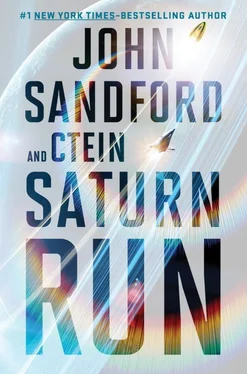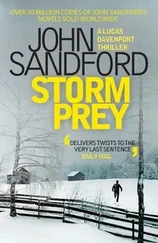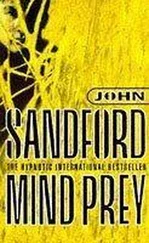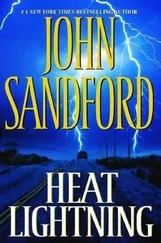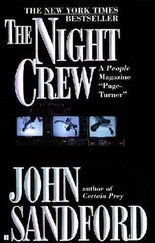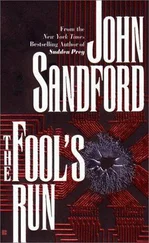In fifteen minutes, he had more vid than Fiorella would ever be able to use, so he picked the best spot, a kilometer out, set two cameras at different focal lengths, picked up his slate, and went back to a novel he’d been reading.
In an hour, the reactors were up to five percent, dumping nearly a gigawatt of heat into the exchanger and radiators. Ribbons streamed out at twenty meters a second. The reactor managers sounded happy. The heat exchanger engineers sounded happy. Dr. Johansson sounded slightly less stressed than usual. Sandy went back to his novel, a bit of undemanding popular science-fictional fluff about the first space mission to Jupiter. Set ten years in the future, he thought. How quaint: this mission would blow Jupiter’s doors off.
Each time he scrolled the tab’s screen, Sandy glanced up at the sails. The Reds would run fine on their own, unattended, he was just spot-checking. As the station moved in its orbit about the earth, the sun’s light constantly changed angles and intensity. There was the especially dramatic transition from lightside to darkside and vice versa on the earth. Sure, it was repeated every two hours, but audiences lapped it up. More eye candy he could edit into the footage so that viewers wouldn’t notice that nothing interesting was happening. Occasionally he panned across the earth to capture the sunset/sunrise terminator and its delicate rainbow, or the lights from humanity’s bigger and brighter megaplexes.
Two and a half hours into the test, Fiorella and Martinez came out in separate eggs, Fiorella’s egg slaved to Martinez’s. Sandy spent an hour doing close-up shots of Fiorella in her egg, commenting on the sails in the background. Martinez hovered behind Sandy, out of camera range.
When they were satisfied with the vid, Martinez and Fiorella looped over to the far side of the test ribbons, so that Sandy could shoot them with the ribbons in the foreground, the earth in the background.
The reactors were up to twenty percent. The heat exchanger was happily dissipating 3.5 gigawatts, its ribbons zipping along at seventy meters per second. Out of the corner of his eye, Sandy caught a glimmer of light off one of the sails. Something different.
He said, “I’m seeing something different out there, what’s… Hey! You guys! Joe! Cassie! Back up! Back up! Get out of there, get away!”
He started to zoom in on that section of that sail with Camera 1, his longest lens, when he saw more glimmers, then ripples of light starting to flicker across the sail. He zoomed Camera 2, catching the ripples, but carefully kept Fiorella’s and Martinez’s eggs in the shot, then thumbed over to object-lock, locking Fiorella’s egg onto Camera 2. It would track her wherever she went, within the limitations of his egg’s attitude and the Red’s gimbals. Martinez was backing them off, as the ripples and flickers extended over all four sails.
A second later, the sails exploded.
That’s what it looked like, anyway, from Sandy’s vantage point.
The three hundred and fifty-two silvery metal ribbons making up the sails broke free of their lock-step, straight-as-arrow paths and went flying wildly into space, thin silver streamers spewing out in all directions like Christmas tinsel.
He’d dealt with any number of explosions in the Tri-Border area, and one of the things that he had learned was that if the explosion didn’t kill you outright, you could get killed by the stuff coming down. Like bricks. He’d trained himself to look up after something blew: a flying brick was like a softball lofted into the outfield, and you could easily dodge it, if you could see it. Your mind would automatically scope out the vectors of the various flying pieces of rubble.
As the cloud of silvery threads grew, Sandy saw a hole forming in the expanding ball of chaff, and his explosion-trained brain told him the various object vectors wouldn’t be passing through the hole. He jammed the egg into it, careful to keep the egg oriented toward Fiorella’s and Martinez’s eggs, so Camera 2 could track them. He put Camera 1, with the half-million-dollar lens, on the corner of the extruder where the ripples had started and thumbed the constant focus setting, and closed in on it, at the same time selecting both real-color and thermal settings, and the highest recording speed.
As he dove in on the extruders, Martinez started screaming at him: “Get out of there, you crazy motherfucker. Go north, go north. Get out…”
Fang-Castro’s cool voice interrupted: “Mr. Darlington, do what you think best. Those vids will be valuable. Mr. Martinez, try not to distract Mr. Darlington any more than is necessary to warn him of a problem he may not be able to see.”
Then another woman’s voice, as cool as Fang-Castro’s: “This is Johansson. Darlington, we’re monitoring your vid. We could use a full scan of the extruder bar at your best resolution in both real color and thermal—”
“Doing that, real color and thermal, I’ll need to close a bit more to get the best resolution.”
Although he was focused on the technical video going into Camera 1, he made sure that Camera 2 stayed locked on Fiorella. He was shooting her through the expanding ball of silvery chaff, and though he knew at the back of his mind that the chaff represented a disaster, it was also one of the most beautiful things he’d ever seen, the metallic strands writhing in the sunlight, with the blue-marbled Earth far below: and Fiorella’s egg right in the center of the shot.
As an honorary techie, he was appalled. Something had gone badly wrong. The test was clearly a failure. Was it a fatal one, in terms of either the mission or the people? He switched his headset over to the engineering channels the Red had been recording and caught the stream of reports coming into the chief reactor manager and Becca Johansson and quickly caught up on the status.
No permanent damage done to the station or to the mission, no human injuries of any kind, though Johansson sounded mightily pissed off. From what he could tell, the ribbon guidance system had cratered. As the speed of the ribbons increased, an instability appeared. From what he could hear over the audio links, the engineers didn’t know if it was vibration in the extruders or some sort of feedback loop between the ribbons and the sensors and the control magnets, or if the computer controls hadn’t been up to the task.
Whatever, those fast-flying ribbons had developed wobbles and the wobbles had grown uncontrollably until finally the whole control system collapsed under impossible demands and the ribbons started flying off in all directions.
He’d reached the end of the extruder bar and he clicked over to the engineering channel and asked, “You need another run on the extruder bar?”
Johansson came back almost immediately.
“If you can, give me a thermal image of the end of the bar where the instability started. Just leave it there for a while. Two minutes, anyway.”
“Doing that now,” Sandy said.
Fiorella called, “I don’t want to seem crass,” she began.
“Never bothered you in the past,” Sandy said.
“I’m laughing inside,” she said. “Tell me that you got at least a few seconds of our eggs floating in the background, when the thing blew.”
“Camera two was locked on you the whole way, and still is. The chaff is clearing out. If you want to motor over this way, we could do a tracking shot of you coming in, right up to your face. Dodge around a few pieces of the metal—that should look pretty spectacular.”
Fiorella asked, “Joe, can we do that?”
“Yeah, we can do it, but I still say he’s a crazy motherfucker.”
Crazy motherfucker I might be, Sandy thought, and it was all chaos theory in motion and one hell of a screwup: but, ohmigawd, that’s entertainment !
Читать дальше
